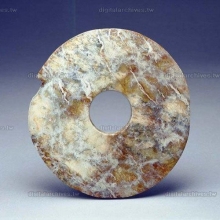|
Tags: jade | plate
 This Liangchu culture jade plate is flat, round and plain, with no decoration. It has a circular hole 4.5 centimeters in diameter in the center, and a spiral design by the hole. The surface and the outer rim of the jade plate are not very smooth; there is some damage on the outer rim. As a result of being buried in the ground for a long period and being affected by minerals, it has colorful patches and veins on its surface. Judging from the material, the quality of the jade piece is actinolite nephrite, which contains more than two percent iron. The Mohs hardness level is above five.This jade plate was originally unearthed from a well in Shuangqiao County, Chiaxing, Zhejiang. It is an artefact of the Liangchu culture of the late Neolithic Age. The Liangchu culture dates from 5,300 to 4,200 years ago, and was primarily spread around the Taihu region. Among all the cultures of the Neolithic Age, the jade utensils of the Liangchu culture are regarded as the best in quality, quantity, style and craftsmanship. The unearthed Liangchu jade utensils were discovered in sets, more than thirty types in total. Besides serving as ritual utensils in religious ceremonies, they were also ornamentals symbols of power and royalty.
This Liangchu culture jade plate is flat, round and plain, with no decoration. It has a circular hole 4.5 centimeters in diameter in the center, and a spiral design by the hole. The surface and the outer rim of the jade plate are not very smooth; there is some damage on the outer rim. As a result of being buried in the ground for a long period and being affected by minerals, it has colorful patches and veins on its surface. Judging from the material, the quality of the jade piece is actinolite nephrite, which contains more than two percent iron. The Mohs hardness level is above five.This jade plate was originally unearthed from a well in Shuangqiao County, Chiaxing, Zhejiang. It is an artefact of the Liangchu culture of the late Neolithic Age. The Liangchu culture dates from 5,300 to 4,200 years ago, and was primarily spread around the Taihu region. Among all the cultures of the Neolithic Age, the jade utensils of the Liangchu culture are regarded as the best in quality, quantity, style and craftsmanship. The unearthed Liangchu jade utensils were discovered in sets, more than thirty types in total. Besides serving as ritual utensils in religious ceremonies, they were also ornamentals symbols of power and royalty.
National Museum of History
|